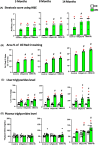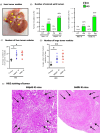The role of inflammation induced by necroptosis in the development of fibrosis and liver cancer in novel knockin mouse models fed a western diet
- PMID: 39514172
- PMCID: PMC12181472
- DOI: 10.1007/s11357-024-01418-3
The role of inflammation induced by necroptosis in the development of fibrosis and liver cancer in novel knockin mouse models fed a western diet
Abstract
Non-resolving, chronic inflammation (inflammaging) is believed to play an important role in aging and age-related diseases. The goal of this study was to determine if inflammation induced by necroptosis arising from the liver plays a role in chronic liver disease (CLD) and liver cancer in mice fed a western diet (WD). Necroptosis was induced in liver using two knockin (KI) mouse models that overexpress genes involved in necroptosis (Ripk3 or Mlkl) specifically in liver (i.e., hRipk3-KI and hMlkl-KI mice). These mice and control mice (not overexpressing Ripk3 or Mlkl) were fed a WD (high in fat, sucrose, and cholesterol) starting at 2 months of age for 3, 6, and 12 months. Feeding the WD induced necroptosis in the control mice, which was further elevated in the hRipk3-KI and hMlkl-KI mice and was associated with a significant increase in inflammation in the livers of the hRipk3-KI and hMlkl-KI mice compared to control mice fed the WD. Overexpressing Ripk3 or Mlkl significantly increased steatosis and fibrosis compared to control mice fed the WD. Mice fed the WD for 12 months developed liver tumors (hepatocellular adenomas): 28% of the control mice developing tumors compared to 62% of the hRipk3-KI and hMlkl-KI mice. The hRipk3-KI and hMlkl-KI mice showed significantly more and larger tumor nodules. Our study provides the first direct evidence that inflammation induced by necroptosis arising from hepatocytes can lead to the progression of hepatic steatosis to fibrosis in obese mice that eventually results in an increased incidence in hepatocellular adenomas.
Keywords: Chronic liver disease; Hepatocellular adenoma; Liver cancer; Mixed lineage kinase domain–like protein (Mlkl); Receptor-interacting protein kinase (Ripk3).
© 2024. This is a U.S. Government work and not under copyright protection in the US; foreign copyright protection may apply.
Conflict of interest statement
Declarations. Conflict of interest: The authors declare no competing interests.
Figures







Similar articles
-
Characterization of novel mouse models to study the role of necroptosis in aging and age-related diseases.Geroscience. 2023 Dec;45(6):3241-3256. doi: 10.1007/s11357-023-00955-7. Epub 2023 Oct 4. Geroscience. 2023. PMID: 37792157 Free PMC article.
-
Impact of Mlkl or Ripk3 deletion on age-associated liver inflammation, metabolic health, and lifespan.Geroscience. 2025 Jun;47(3):4465-4483. doi: 10.1007/s11357-025-01553-5. Epub 2025 Feb 10. Geroscience. 2025. PMID: 39930289 Free PMC article.
-
Hepatocyte necroptosis is associated with liver damage in dairy cows with ketosis.J Dairy Sci. 2025 Aug;108(8):8844-8858. doi: 10.3168/jds.2025-26349. Epub 2025 Jun 11. J Dairy Sci. 2025. PMID: 40513868
-
Transient elastography for diagnosis of stages of hepatic fibrosis and cirrhosis in people with alcoholic liver disease.Cochrane Database Syst Rev. 2015 Jan 22;1(1):CD010542. doi: 10.1002/14651858.CD010542.pub2. Cochrane Database Syst Rev. 2015. PMID: 25612182 Free PMC article.
-
Linking necroptosis with liver aging and chronic inflammation in hepatic pathology.Life Sci. 2025 Jul 18;379:123871. doi: 10.1016/j.lfs.2025.123871. Online ahead of print. Life Sci. 2025. PMID: 40685068 Review.
Cited by
-
Western Diet and Cognitive Decline: A Hungarian Perspective-Implications for the Design of the Semmelweis Study.Nutrients. 2025 Jul 27;17(15):2446. doi: 10.3390/nu17152446. Nutrients. 2025. PMID: 40806031 Free PMC article. Review.
References
-
- Franceschi C, Campisi J. Chronic inflammation (inflammaging) and its potential contribution to age-associated diseases. J Gerontol A Biol Sci Med Sci. 2014;69(Suppl 1):S4-9. - PubMed
-
- Spaulding CC, Walford RL, Effros RB. Calorie restriction inhibits the age-related dysregulation of the cytokines TNF-α and IL-6 in C3B10RF1 mice. Mech Ageing Dev. 1997;93(1–3):87–94. - PubMed
-
- Masternak MM, et al. Dwarf mice and aging. Prog Mol Biol Transl Sci. 2018;155:69–83. - PubMed
MeSH terms
Substances
Grants and funding
LinkOut - more resources
Full Text Sources
Medical
Miscellaneous

